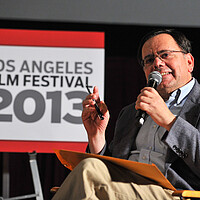‘Road Diary’ documentary offers a front-row seat to stellar Bruce Springsteen
Documentaries about performing artists are only as interesting as the artists being documented. In the case of “Road Diary: Bruce Springsteen and the E Street Band,” one needn’t fret. The Boss is entirely captivating.
So is the movie – sort of. Directed by longtime Springsteen documentarian Thom Zimny, it chronicles the worldwide concert tour of the E Street Band in 2023 after a six-year hiatus from performing in front of a live audience.
On the downside, we are subjected to way too many close-ups of adoring fans blissing out. Concert movies, especially ones like this that are essentially authorized by the artists, often skirt hagiography. “Road Diary” frequently tips over the edge.
On the plus side, we get a front-row seat, often closer than that, to some of the wowiest concerts ever committed to film. With ticket prices being what they are these days, this is no small benefit. (Think of all the Swifties who had to “settle” for the “Eras Tour” documentary.)
Another plus: Streaming the film at home means that, without the surrounding roar of the fans, you might actually be able to hear the songs. You also won’t have to be standing up the whole time to see the stage.
The documentary is being publicized as the most in-depth cinematic look ever at Springsteen and the workings of his band. I suppose that’s true, although his 2016 memoir “Born to Run” and his subsequent solo show on Broadway were more personally revelatory.
Scant mention is made of his disbanding the band prior to its regrouping. Longtime collaborator Steven Van Zandt’s feuds with Springsteen are skimped. Along with many of Springsteen’s other collaborators, Van Zandt is featured heavily in “Road Diary,” and mostly he’s on his best behavior. He does throw in one telling gibe, though, noting that Springsteen now dubs him the band’s music director – “some 40 years too late, but who’s counting?” Well, uh, he is.
Van Zandt also mentions that when he and his boyhood friend were growing up in New Jersey, Springsteen was “the most introverted guy you ever met.” This observation doesn’t exactly align with the early firebrand who would literally throw himself into the audience during concerts. But it makes sense. Great showbiz performers, many of whom struggle with stage fright, often only come alive on stage. The spotlight is their cue to shine.
In “Road Diary,” which also includes archival and rehearsal footage, Springsteen is afforded ample time to be contemplative. He bemoans the loss of veteran band musicians Clarence Clemons and Danny Federici. Patti Scialfa, his wife and bandmate, talks about her battle with cancer. The rocker ruminates on the passage of time.
“After 50 years on the road,” says the 74-year-old, “it’s too late to stop now. I plan on continuing until the wheels come off and for as long as the audience will follow me.”
When I saw this film at the Toronto Film Festival, I wrote that a great documentary could be made “about the ways in which still-performing rock ’n’ rollers like Springsteen and the Rolling Stones have transitioned into seniority.”
“Road Diary” isn’t that film, but it carries wisps of a larger subject. Obviously what keeps these artists going – Neil Young, Bob Dylan, and Willie Nelson are other prime examples – is something far more deep-seated than financial gain or mere adulation. I suspect it’s more like a sense of gratitude for the gifts they have been given and are still able to share. The gratitude runs both ways.
Peter Rainer is the Monitor's film critic. “Road Diary: Bruce Springsteen and the E Street Band” is rated TV-MA, for mature audiences. It is streaming on Disney+ and Hulu starting Oct. 25.






